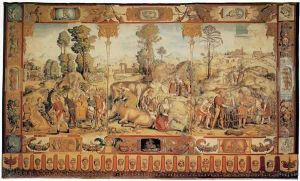Nicolas Karcher Paintings
Nicolas Karcher, also known as Niccolò Vicentino, was an Italian engraver who was active during the Renaissance period. Despite the lack of precise information regarding his birthdate, Karcher was a figure of significance in the 16th century due to his contributions to the art of engraving. His exact origins remain unclear, and art historians have not been able to pinpoint his birth year reliably. However, it is known that he died in 1550.
Karcher's works are characterized by their intricate detail and the influence of prominent artists of his time. He was primarily known for his skill in the 'chiaroscuro' woodcut technique, a method that involved using different tones and shades to create a sense of depth and volume. This technique was relatively new at the time and was used by only a handful of artists to create prints that appeared more lifelike and three-dimensional.
The chiaroscuro woodcuts by Karcher were based on designs by other artists, such as Parmigianino, and these collaborations resulted in prints that combined Karcher's technical prowess with the artistic flair of the designers. His works were instrumental in the dissemination of the styles and aesthetic preferences of the Italian Renaissance throughout Europe, as prints could be produced in greater numbers than paintings and could reach a wider audience.
Although exact details of his life and training are scarce, Karcher's body of work suggests that he was deeply engaged with the artistic community of his time and was likely connected with other printmakers and workshops. His death in 1550 marked the loss of an artist who contributed significantly to the development of printmaking techniques, and his works continue to be studied and appreciated for their beauty and technical excellence.
Due to the relative obscurity of his life and the commonness of his name, there is some difficulty in distinguishing his biography from those of other artists with similar names from the same era. Consequently, there might be some confusion or conflation with the biographical details of contemporaries. Nonetheless, Nicolas Karcher's legacy as an engraver remains intact, with his prints held in various art collections and museums around the world, offering insight into the innovative printmaking practices of the Renaissance.
